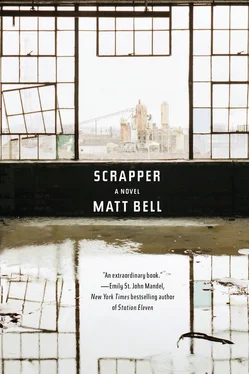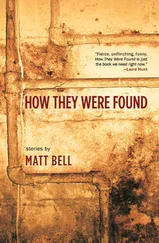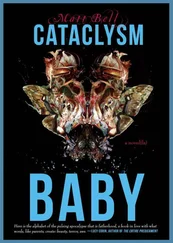THE RAPPER HAD THREE NAMES: his father had named him first, then he had given himself a rap name, and then later still he gave himself a Muslim name. The freedom of life under an alias, then the charge of a truer name, the strived-for self, after the alias had become a product, commodified, shrink-wrapped, labeled with parental-advisory stickers. His publicist asked reporters to call him by his Muslim name but the reporters put his rap name in parentheses, didn’t care if this wasn’t who he was anymore, preferred its controlled danger.
Now the rapper could move freely again, work within his new title. The rapper had given up one name to become a new person and in the press briefing his first day at Guantánamo he listened as the base commander offered his own names for the new world he wanted the rapper and the documentary crew he’d accompanied to see: These were not prisoners, the commander said, but detainees. This was a detention facility, not a prison. The detainees had not been captured, only rendered, turned over, extradited. This was not a court. The soldiers did not work in a courthouse. This was a military tribunal, meeting in the Expeditionary Legal Complex.
Language replaced what could no longer be borne, terrorist became enemy combatant became unprivileged belligerent , each phrase meaning less than the one before. The official view of the legal complex could only be photographed from one particular location, a three-foot square spray-painted onto a walkway, requiring a certain kind of tunnel vision. They were permitted to capture only what lay between two green lightposts, the legal complex barely visible over a series of fences, silver chain link, green sniper netting, coils of razor wire, a red anticar barricade. The barest aperture through which to glimpse a secret. There could be no photos of detainees’ faces, no photos of large stretches of the coastline, no images of unoccupied guard towers, a rule that admitted there were unoccupied guard towers. Whether they followed the rules or not, every photo would be either approved or deleted at the end of every day and there would be no appeals.
The commander: buzz cut, pressed uniform, stern face. Everything about him so expected it was hard to fix his features in memory. The commander didn’t say but the rapper knew whatever he asked the detainee could be used against the detainee. The rapper had come to help him but not in the military courts, only at home, in the public eye. The slow progress of art: the crisis was happening now but the solution waited in the future. The detainee’s release hearings were under way again. He was uncharged and never convicted of anything but he had not been sent home and this was what the rapper had come to make happen. But even if art could move the masses — and this the rapper no longer knew, although he had staked his life on the question — it would not move them soon. The director said they’d have to hit the festival circuit before any general release, could maybe seek a streaming deal to speed up the process. Six months, a year.
The photographs:
Approved: The personal items given to each detainee. Orange jumpsuit. White underclothing. Blue flip-flops. Blue laceless shoes. Olive-green jumpsuit. A bottle for water. A copy of the Koran. Comfort items, prayer rugs, sudoku. A clear plastic container to store these possessions.
Approved: The spoon, the spork, the plastic knife. Yellow cake. Onion and garlic. Soft fruit. Bread. Tiny packets of salt and pepper and ketchup and honey, all the tiny condiments of the tiny life.
Approved: A single shelf of the detainee library. An array of foreign-language newspapers. USA Today . Teen paranormal romance translated into Arabic. Materials for a living-skills course on home budgeting and résumé writing.
Approved: A plush recliner in a room meant for a single detainee’s television privileges, to be enjoyed in leg chains, also pictured.
Approved: A photo of the commander standing in the hallway of one of the detainee camps. Photographed from the rear to hide his face. The walls and floor of the camp gleaming. The clean silence of a photograph.
Approved: A painted arrow stenciled onto the concrete, pointed toward Mecca. So detainees knew which direction to send their prayers.
Approved: Cans of nutritional supplement, a single stretch of feeding tube. Supplies stockpiled against a growing hunger strike.
Approved: A hospital bed inside a chain-link fence. The detainee medical clinic.
Approved: A sign reading detainees in vicinity — maintain silence.
Approved: A sign bearing the slogan safe humane legal transparent.
Approved: A sign reading no photography.
Deleted: A white board in the commander’s office with a handwritten note: top story this week — rules inconvenience reporters.
Deleted: A photo of a water tower, though the water tower could be seen online, on publicly available maps.
Deleted: A photo of a communications antenna, despite the same.
Deleted: A length of film where a detainee’s face accidentally showed in a window.
Deleted: A length of film where a migrant kitchen worker stopped facing away, turned toward the camera.
Deleted:
Deleted:
Deleted:
Deleted: They couldn’t remember everything. This was the point. They had outsourced their memory to film and photograph and their memory was being deleted.
Deleted: The face of Adnan Fahim.
Adnan Fahim. This was the man the rapper had come to see. Detained in Yemen in 2002 on suspicion of giving material support to terrorists. Twenty-one years old at the time. Active for less than three months from first contact to capture. Held and interrogated overseas in a top-secret black site for four years, then transferred here, interrogated again, during the years referred to as Bad Old Gitmo. Torture between 2002 and 2008 meant everything they’d made him say wasn’t admissible in court but so far no release was forthcoming, only more hearings, more imprisonment. They hadn’t questioned him in five years. All previous evidence was tainted but reports suggested the government had once expected him to be charged in 2006 under a retrospective law changing the definition of material support . By then he had already been designated an enemy combatant , before there was an official definition — but then the definition turned out to be if the president said you were an enemy combatant then that was what you were.
The rapper was allowed into the windowless cell first, directed to take his seat across from the door. The commander said the detainee would be brought shortly but there could be delays. They would let the rapper get tired, let him lose his nerve. There were no clocks inside the room, no cell phones or watches allowed. A nervous boredom accumulated. He smelled the sour stink of his body, already sweating in the humidity and the tight box of the cell. He had been instructed not to touch the detainee — always the detainee , never Adnan Fahim— and also not to ask him for any information possibly deemed classified. There would be no one else in the cell with them but a guard would be posted outside, with the commander listening on a monitor nearby. If at any moment his line of questioning veered from his instructions, then the interview would be terminated.
The door opened. Adnan Fahim entered alone, his slim frame draped by an olive-green jumpsuit, a body belt of chains hanging from his wrists to his ankles. Adnan was one hundred days into a campwide hunger strike but he wasn’t allowed to starve himself and so the man before the rapper didn’t match the mental image of a hunger-strike victim. The rapper had seen a file photo of Adnan but the photo was from years earlier and the Adnan chained to the chair was older, his face more tired, more worn. Only the sharp expression in Adnan’s eyes had not changed. This was a man the rapper believed he could talk to, who would make a compelling testimonial against the persistence of the camp, help reignite the rage necessary to close it.
Читать дальше












